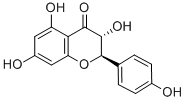Description:
Aromadendrin, which usually comes from the bark of Eucalyptus calophylla, exhibits anti-inflammatory activity through the suppression of nuclear translocation of NF-κB and phosphorylation of JNK in LPS-stimulated RAW 264.7 macrophage cells. Aromadendrin may represent a potential therapeutic candidate for the management of type 2 DM.
- Molecular Weight: 288.3
- Molecular Formula: C15H12O6
Purity: >98%
Canonical SMILES:
C1=CC(=CC=C1C2C(C(=O)C3=C(C=C(C=C3O2)O)O)O)O
InChI:
InChI=1S/C15H12O6/c16-8-3-1-7(2-4-8)15-14(20)13(19)12-10(18)5-9(17)6-11(12)21-15/h1-6,14-18,20H/t14-,15+/m0/s1
InChIKey: PADQINQHPQKXNL-LSDHHAIUSA-N
- Boiling Point: 638.00 to 639.00 °C. at 760.00 mm Hg
- Melting Point: 247 - 249 °C
- Appearance: Powder
- Application: Anti-inflammatory/antioxidant/anti-diabetic
Synonyms:
3,5,7,4'-Tetrahydroxyflavanone; Dihydrokaempferol; aromadedrin; (2R)-2,3-Dihydro-3β,5,7-trihydroxy-2-(4-hydroxyphenyl)-4H-1-benzopyran-4-one; (2R,3R)-2,3-Dihydro-2-(4-hydroxyphenyl)-3,5,7-trihydroxy-4H-1-benzopyran-4-one; Katuranin
More details are to be found on supplier website
